Why is your Dogwood tree dying? If you've ever wondered, "What does a dying dogwood tree look like?" or "How do I revive my dogwood tree?" you're in the right place.
Often, a quick look at the tree bark can reveal signs of disease.
Signs of distress often appear in the bark or leaves of your Dogwood.
These issues show up as symptoms like peeling bark, leaf loss, or wilting leaves.
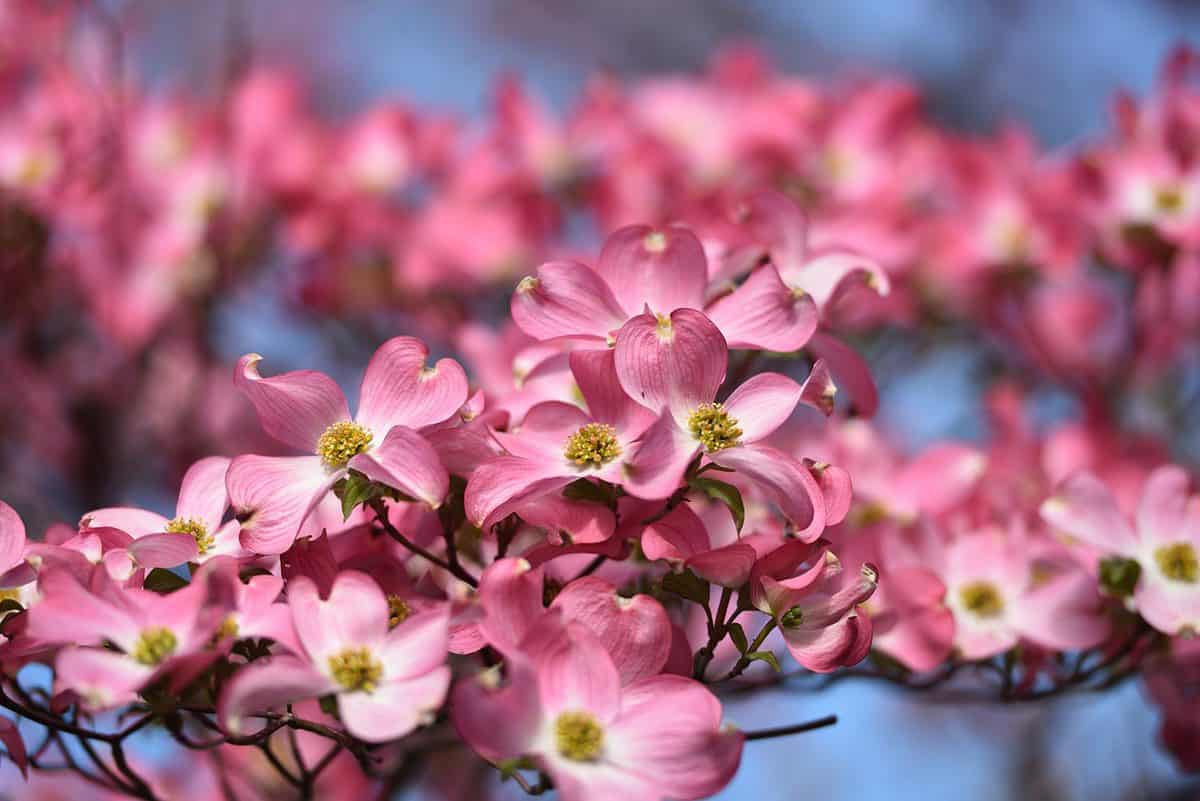
Various factors can cause these changes. Root rot, diseases making leaves turn brown, and other issues can harm your Dogwood.
This guide aims to assist you in determining what could be troubling your tree.
We'll view some dogwood tree disease pictures, explore the advantages of using Epsom salt, and more.
Let's get to the root of these symptoms and help your Dogwood flourish again.
Common Issues And Treatments
Ensuring the health of your Dogwood tree requires vigilance to the various challenges it might face.
Whether it's a result of environmental factors such as the tree getting too much sun or diseases like powdery mildew, understanding the root cause is crucial.
Let's navigate some of the most common issues Dogwood trees encounter and their treatments.
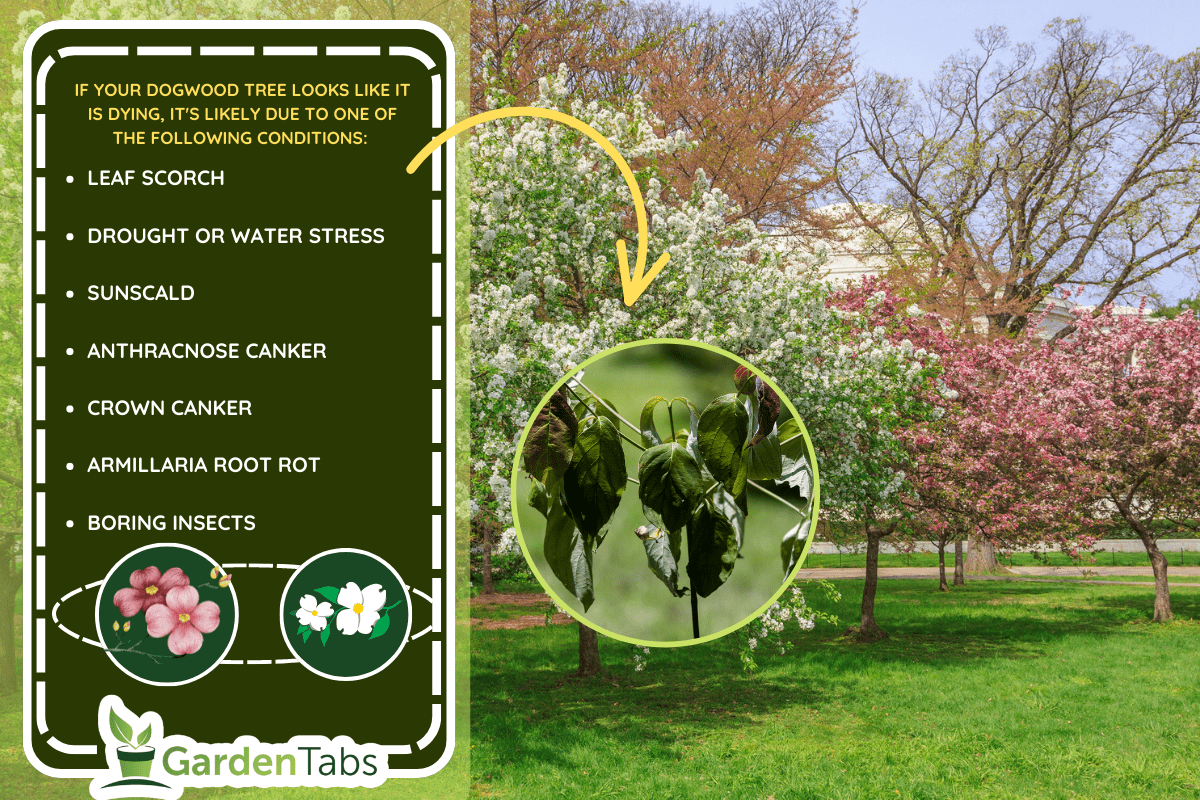
#1 Leaf Scorch
Dogwood trees naturally grow in forests and are used to lots of shade. Leaf Scorch happens when your dogwood is exposed to " data-lasso-id="53401">too much sun or doesn't get enough water.
This symptom can appear as irregular dead spots on leaves or flowers with purple tints.
If the edges of your dogwood's leaves turn brown, it signals a problem—the tree needs more water or afternoon shade.
Will Leaf Scorch Kill a Dogwood Tree?
Fortunately, leaf scorch won't kill your dogwood unless you don't treat it. Leaf scorch is your dogwood's way of telling you it needs something.
Providing shade is essential since Dogwoods don't tolerate full sun.
You might need to transplant your dogwood to a shaded location.
More water is the solution for those already shaded but still showing signs of Leaf Scorch.
Dogwood Care Tips from an Expert: Want more about dogwood tree problems? Watch the video below.
Dr. Kelly talks about the signs when a dogwood tree is not happy. She also shares where these trees naturally like to grow. Plus, she advises on how to take care of them.
From drought stress to the intricacies of its habitat, this video provides valuable insights directly from an expert's perspective.
#2 Drought and Insufficient Water
If your dogwood tree shows signs of leaf discoloration or wilted leaves, especially post-transplantation, it might suffer from drought.
The prolonged lack of water can even damage the tree bark.
Long periods without enough water lead to these drought conditions. The repercussions of such conditions include leaf discoloration, wilted leaves, or trunk damage.
How to Combat Drought:
Mulching: Mulch acts as a protective blanket for the soil, maintaining moisture and regulating temperatures.
Organic materials like bark, straw, leaves, and coir are ideal. When mulching, ensure it doesn't directly touch the dogwood's trunk.
This precaution prevents potential rotting or pest issues.
Regular Monitoring: Keep a close eye on your dogwood during hot and dry spells.
Look out for signs of stress, such as leaf wilting, tree bark cracking, or trunk splitting.
If you observe any of these signs, it might be time to intervene with added watering or mulching.
#3 Water Stress/Too Much Water
Excessive water can pose significant challenges for dogwood trees, leading to various complications.
Soil Drainage: Proper drainage is paramount for the optimum health of dogwood trees.
When soil retains excessive water, it can cause the roots to suffocate, eventually leading to rot.
Damaged Root System: Even if a tree has access to too much water, a compromised root system might hinder the tree from absorbing the necessary moisture.
How to Alleviate Water Stress:
Improve Soil Composition: A balanced soil mix can help achieve the desired drainage level and prevent water logging.
You might consider amending your soil with materials like compost or sand to attain this balance.
Regular Inspection: Regularly checking your tree's base and surrounding areas is essential.
If the ground feels overly damp, consider adjusting your watering routines.
Click Here To See This Indoor/Outdoor Soil On Amazon
#4 Sunscald
" data-lasso-id="53407">Sunscald, distinct from typical sun damage, is caused by exposure to intense winter sun, typically affecting the southwest side of the tree.
This condition manifests as elongated, discolored, sunken scars on the tree bark, which can eventually cause it to peel away.
Such damage provides an entry point for pests and diseases.
The Solution To Sunscald:
Consider wrapping the trunk with a commercial tree wrap or a light-colored tree guard to prevent sunscald during winter.
These wraps reflect the sun and prevent the bark from heating up excessively.
Remove the wrap in the spring to prevent moisture buildup and pest infestation.
Additionally, strategically planting evergreen trees or shrubs to the southwest of the dogwood can provide natural shade and protection against the winter sun.
Click Here To See This Tree Wrap On Amazon
#5 Anthracnose Canker
This severe fungal disease will kill your dogwood tree if you don't catch it early. Even if you save your tree, you shouldn't transplant shoots because it may still harbor the disease.
Dogwoods east of the Mississippi River are mainly affected by " data-lasso-id="53410">Anthracnose canker.
What Does Dogwood Anthracnose Look Like?
The first sign of anthracnose is spotting on the leaves and flower bracts. The spots can be tan with purple edges, dry brown edges, or large blotches.
In cooler weather, you may notice drooping leaves as well. As the disease spreads, it causes sunken brown areas that can encircle and kill branches.
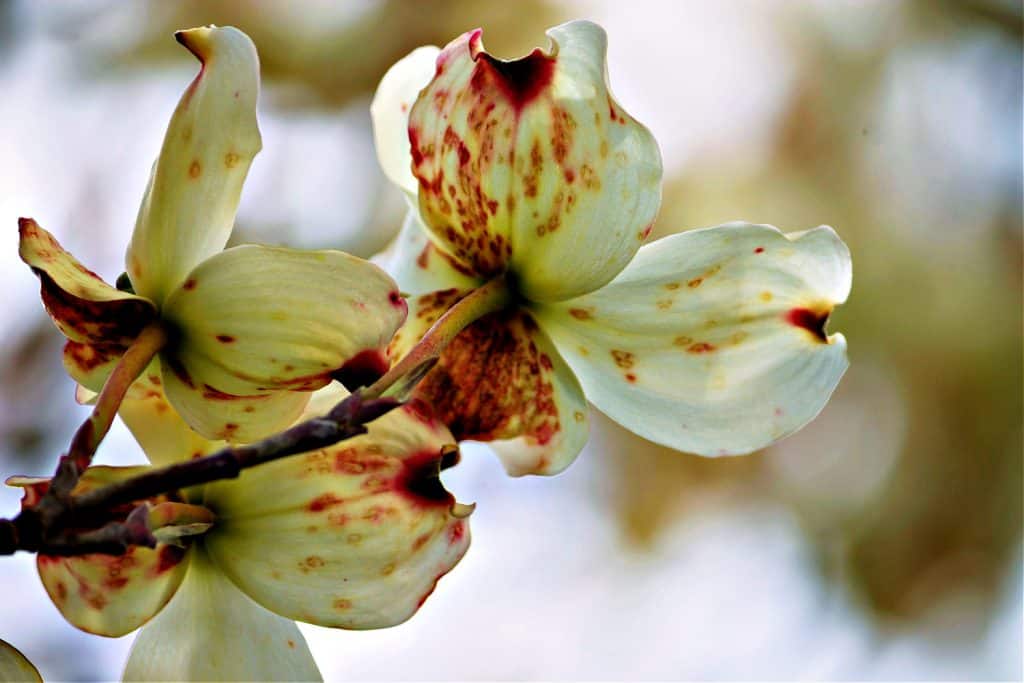
Pruning and Anthracnose
Should your dogwood fall victim to anthracnose, pruning is a lifesaver. Trim and discard infected branches from the garden.
Remove any shoots sprouting due to anthracnose, and ensure good air circulation around the tree.
This can be achieved by raking and eliminating fallen leaves and removing any vegetation competing for space.
Regularly monitor your tree for signs of this disease, and act swiftly at the first hint of infection.
What Is Fungicide Used for Anthracnose?
Before the branches die, you can treat anthracnose using fungicides like chlorothalonil, mancozeb, propiconazole, thiophanate-methyl, or copper.
Before you apply fungicide, you'll need to remove and dispose of all diseased twigs and stems. Remove any small shoots that have sprouted up from the anthracnose.
Provide good air circulation by raking and removing fallen leaves around the tree's Base.
Remove any other vegetation that's crowding it as well. Apply the fungicide in the spring before the buds break through.
Keep a protective coating of the fungicide whenever new growth is present.
Click here to buy fungicides on Amazon.
#6 Crown Canker
Crown canker can cause your dogwood to have tiny leaves that are lighter in color and may curl around the edges.
As the disease progresses, twigs and branches may die on one side of the tree. However, the infection will spread to the entire tree over time.
Upon close inspection, you'll find a dead patch at the tree's base. This patch is gradually encircling the tree and may eventually kill it.
Is Crown Canker Fatal?
A " data-lasso-id="53412">crown canker is usually fatal for a dogwood. However, if you catch it early, you can try cutting out the spot and two inches of healthy bark.
How to Prevent Crown Canker:
Preventing crown canker is a lot easier than treating it. Try to keep your dogwood from getting any wounds that make it vulnerable to disease.
#7 Armillaria Root Rot
This is an aggressive root rot that can attack your otherwise healthy plant. A fungus kills your dogwood by circling the tree's Base.
It's distinguishable by the honey-colored mushrooms growing at the tree's bottom.
How to Deal with Armillaria Root Rot:
You can do nothing to treat a plant with this fungal disease. Ensure you don't plant another dogwood in the same area since it lives in the soil.
#8 Boring Insects
The dogwood borer and the flat-headed appletree borer are two boring insects that can infect your dogwood tree.
An early symptom of borers is bark sloughing off or small wet patches on your tree.
Once these insects get inside the trunk of your dogwood, they are hard to control.
How to Address Boring Insects:
Monitor your dogwood tree closely, especially during the active seasons of these pests. Early detection can often be the key to managing an infestation.
Pyrethrin is a recommended treatment against dogwood borer for homeowners.
Due to the extended presence of dogwood borer adults from late April through July, multiple applications of pyrethrin may be required to achieve effective control.
Click Here To See Pyrethrin On Amazon
#9 Powdery Mildew
Powdery mildew is a fungal disease that appears as a white or gray powder on dogwood tree leaves, causing curling, early leaf drop, and stunted growth.
It thrives in high humidity and poor air circulation.
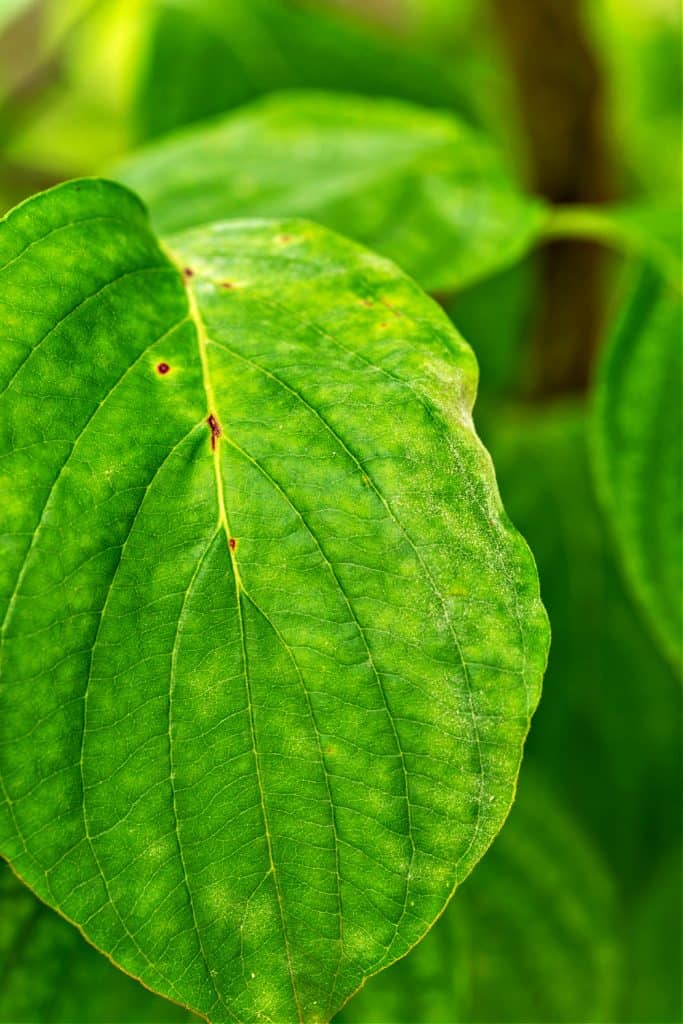
How to Treat and Prevent Powdery Mildew:
To prevent and treat it, ensure good air circulation around the tree, water at the Base to avoid wetting the leaves, and prune infected leaves or branches.
Apply fungicides or neem oil if necessary.
A healthy dogwood, nurtured with proper watering, mulching, and positioning in the right shade, is less likely to succumb to such diseases.
Click Here To See Neem Oil On Amazon
#10 Soil pH Issues
If you've ensured all the above factors and your dogwood still struggles, soil pH might be the issue. Regularly test the soil pH.
How to Address Soil pH Issues:
Regularly test the soil pH. If the soil leans towards being too alkaline, consider amending it with natural or synthetic fertilizers to optimize your dogwood's health.
If feasible, transplanting to a location with a more balanced pH might be beneficial.
Summary Table: Symptoms & Solutions
| Issue | Description & Symptoms | Treatment & Prevention |
|---|---|---|
| Leaf Scorch | Extended water deficiency leads to leaf discoloration. | Provide more water, afternoon shade, or transplant to a shadier location. |
| Drought | Prolonged periods without sufficient water can lead to wilting leaves and trunk damage. | Apply mulch, monitor during dry spells, and provide additional water. |
| Water Stress | Soil retaining too much or too little water or a damaged root system. | Improve soil composition and inspect the base regularly to adjust watering habits. |
| Sunscald | Elongated, sunken, discolored scars due to winter sun exposure. | Wrap the trunk with a commercial tree wrap or a light-colored tree guard during winter. |
| Anthracnose Canker | Fungal disease causing spotting on leaves/bracts, drooping leaves, or sunken brown areas on branches. | Prune and discard infected branches, ensure good air circulation, and use fungicides. |
| Crown Canker | Light-colored tiny leaves, twig/branch death, and a dead area at the tree's bottom. | Early detection and cutting out the affected spot are crucial. |
| Armillaria Root Rot | Root rot is marked by honey-colored mushrooms at the tree's base. | Cannot treat. Avoid planting another dogwood in the same area. |
| Boring Insects | Bark sloughing off or small wet patches due to borers. | Use Pyrethrin for dogwood borers starting in early May. |
| Powdery Mildew | White or gray powder on leaves causing curling, early leaf drop, and stunted growth. | Ensure good air circulation, water at the base, and prune infected leaves or branches. |
| Soil pH Issues | Unfavorable pH affects dogwood health despite other factors being optimal. | Test and amend the soil pH. Consider transplanting to an area with a balanced pH. |
How Do I Know If My Dogwood Tree Is Dying?
Just like other living things, trees can also have problems.
Your dogwood tree might be showing some signs it's not feeling its best.
The big things to look out for are peeling bark, leaves that are curling up, and branches that look dead.
Spotting and fixing these early on can help your tree return to its beautiful self.
Physical Examination: Begin with a thorough visual check. Look for signs of rot, mold, or disintegration starting from the roots.
Check the bark for any discoloration, peeling, or cankers. Leaves may also show discoloration, spots, or early shedding.
Soil Check: Assess the moisture content of the soil. Too wet or too dry soil can be indicative of watering issues.
External Factors: Consider any recent environmental changes - has there been any construction nearby that might have damaged the root system? Was there a significant change in sunlight exposure?
Why Is The Bark Peeling On My Dogwood?
Remember that trees naturally shed some of their bark as they age. It is a normal growth process for many trees, not just Dogwood.
However, excessive peeling could indicate a problem.
Peeling bark on a dogwood tree may signal a health issue or pest infestation. When bark peels off, it exposes the tree's inner layers to disease and insects.
Sunscald occurs when the tree is exposed to intense sunlight, a common cause of peeling bark. Pests like dogwood borers burrow under the bark, causing it to detach.
To address peeling bark, protect the tree from extreme sunlight, especially in winter, and ensure proper watering, fertilization, and mulching to support its overall health.
If you see mushrooms or a dead patch near the tree's base, these are sure signs of a problem.
You should also check your dogwood's leaves thoroughly. Some fungal spots on the leaves are purely cosmetic and don't threaten your tree's life.
Leaf issues like curling, undersized leaves, or scorched spots suggest your tree needs attention.
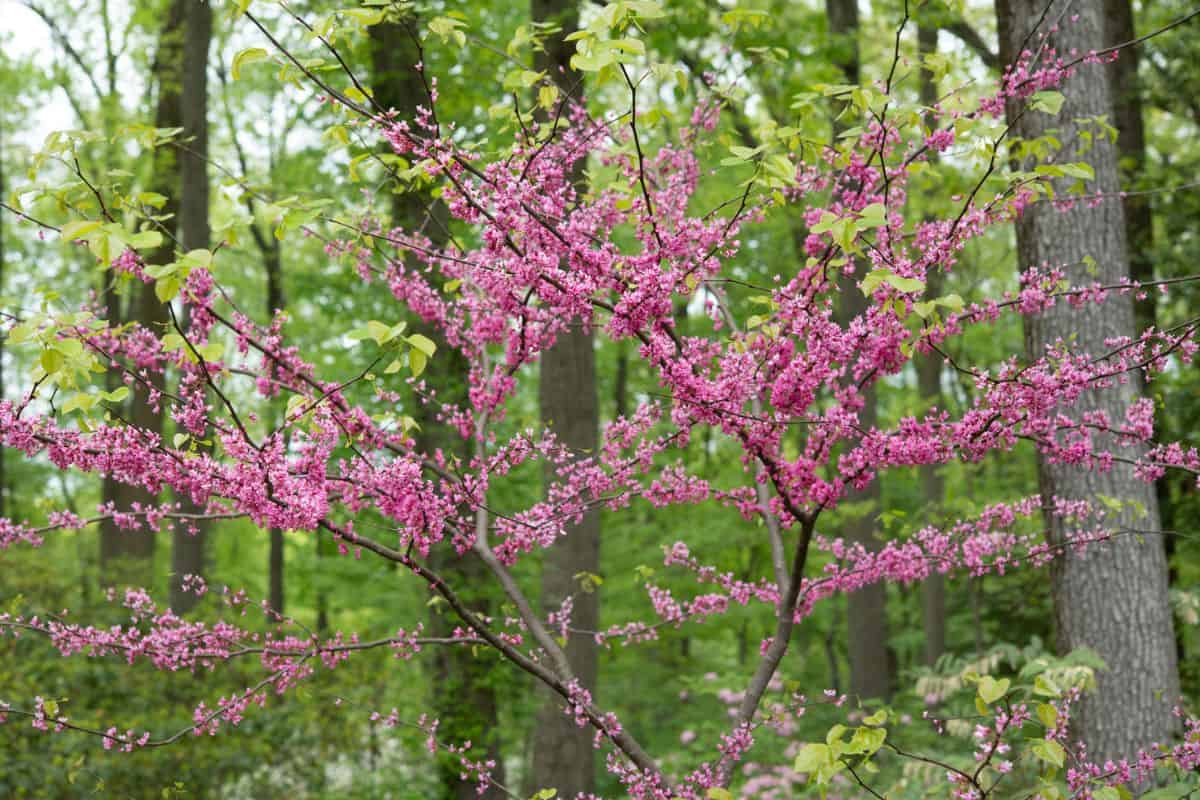
Why Are My Dogwood's Leaves Curling?
Curling leaves can be a sign of several problems with your dogwood. It could be a simple issue, such as your dogwood needs more water or shade.
If that doesn't correct the problem, your dogwood might have a fungal infection. Look closely at the leaves for any spots.
Some fungal infections are harmless and can easily be treated with fungicides.
Curling leaves can also signify certain pests like aphids or whiteflies. Regularly inspect your Dogwood's leaves, especially the underside, for any signs of these pests.
If your dogwood's leaves are curling, closely examine the entire tree. Check the branches for signs of pests and look closely at the tree's trunk to ensure no cankers.
You may deal with cankers if you see dark, sunken spots resembling gouges.
Why Does My Dogwood Tree Have Dead Branches?
As Dogwood trees age, it's natural for some branches to die off. However, excessive dead branches could indicate a deeper problem.
Make sure you prune dead branches to encourage new growth. Regular pruning also helps maintain the tree's health and appearance.
Your dogwood tree may have dead branches because of boring insects or a canker fungus.
If you see a dead branch, inspect the whole tree to identify the cause.
Should You Remove Dead Branches From a Tree?
You should remove dead branches from a dogwood tree. Dead branches provide an entry point for pests and diseases.
Remove these branches at the branch's Base where it meets the trunk. You should also remove crossing branches rubbing each other since these can create limb wounds.
Click Here For These Pruning Shears On Amazon
Revitalizing Your Dogwood with Epsom Salt
As we wrap up our discussion on dogwood tree health, let's discuss a widely-used remedy that can boost the well-being of your tree.
Epsom salt is popular and effective for tree health.
Epsom salt, or magnesium sulfate, can benefit dogwood trees by providing magnesium, an essential nutrient for plant growth.
It can help improve the vibrancy of the tree's flowers, increase nutrient absorption, and enhance the tree's overall health.
Quick Guide To Epsom Salt Application
Direct Application: Mix 2 tablespoons of Epsom salt with a gallon of water. Pour the solution at the base of your Dogwood tree once a month.
Foliar Spray: Mix Epsom salt with water and spray it directly on the leaves for a quicker result.
Soil Amendment: During planting or transplanting, you can add a tablespoon of Epsom salt directly to the hole to enrich the soil.
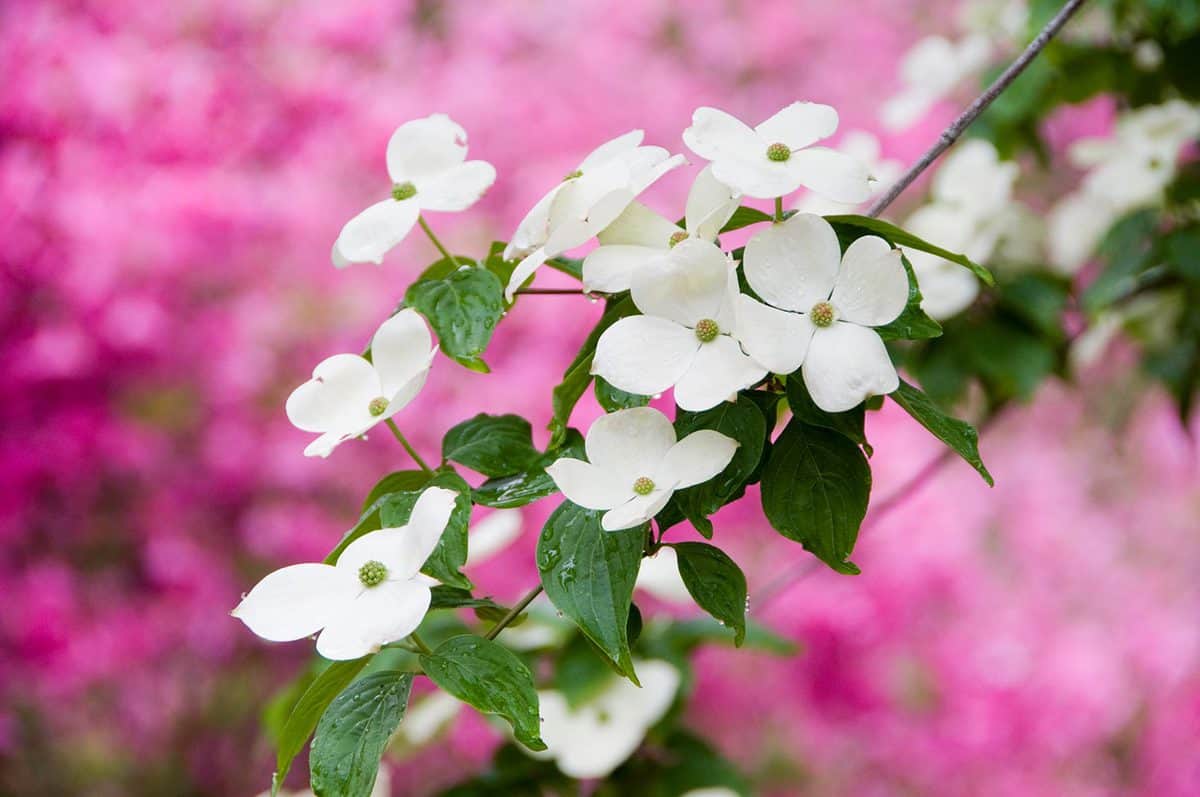
How to Use Epsom Salt for Dogwood Trees: A Guide
1. Soil Test
Before applying Epsom salt, conduct a soil test to determine if your dogwood tree's environment lacks magnesium. Epsom salt is most beneficial when addressing a magnesium deficiency.
2. Prepare the Solution
- Take a clean container or watering can.
- Add two tablespoons of Epsom salt.
- Pour in a gallon of water.
3. Stir the Mixture
Stir the water and Epsom salt mixture until the salt is completely dissolved.
4. Apply to the Base
Gently pour the solution around the base of the dogwood tree, ensuring it seeps into the soil. It's best to apply directly to the root zone.
5. Frequency
Use the Epsom salt solution once a month during the growing season. Remember, consistency is essential for the best results.
6. Watch the Tree's Health and Modify Salt Usage
Keep an eye on your dogwood tree's health after post-Epsom salt application. Observe for healthier leaves or vibrant flowers. Continue with regular care, including watering and fertilization.
After a growing season, re-test the soil for magnesium levels and adjust your Epsom salt usage accordingly.
Click Here To See This Epsom Salt On Amazon
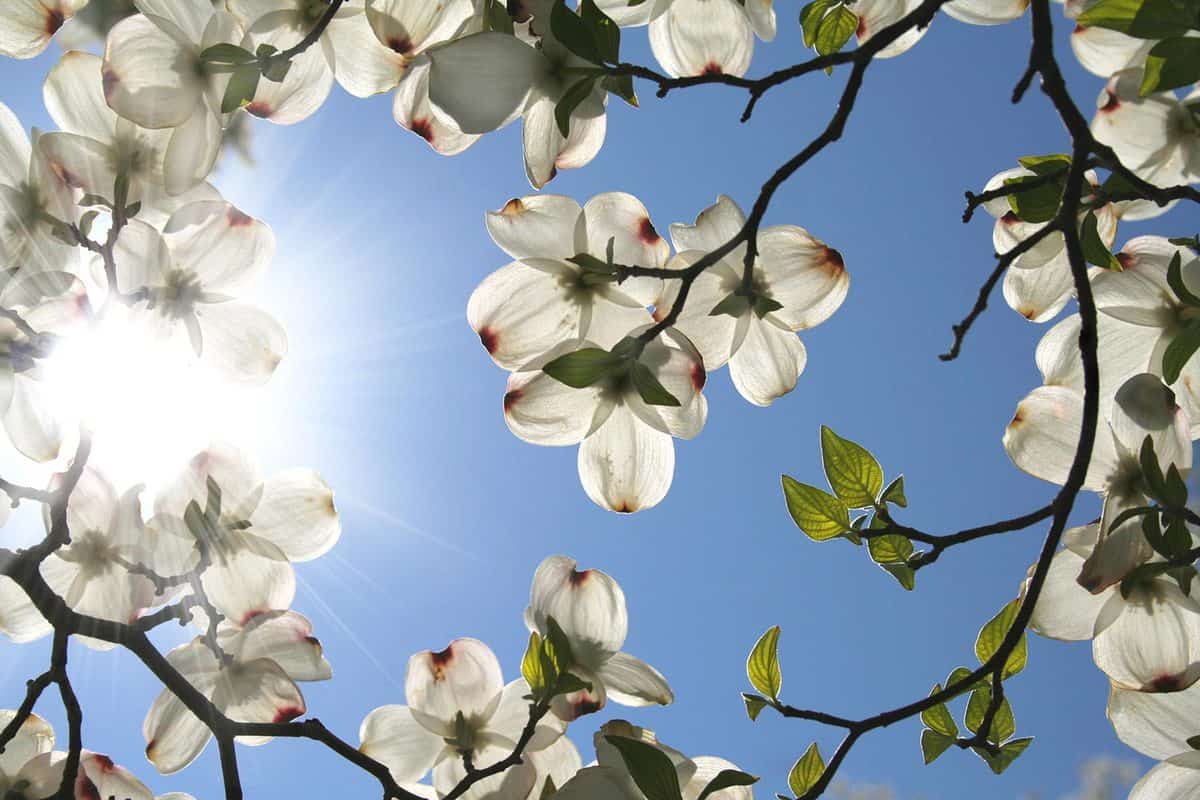
Frequently Asked Questions
FAQs: Planting and Growth
When is the best time to plant a Dogwood tree?
Dogwoods are best planted in the fall or early spring. This allows them to establish roots before the hot summer or cold winter.
How tall can dogwood trees grow?
Generally, they grow between 15 and 40 feet. Dwarf varieties may only reach 8-10 feet.
How fast does a Dogwood tree grow?
Typically, Dogwood trees grow about a foot a year. However, this can vary depending on soil quality, water availability, and sunlight.
What is the lifespan of a dogwood tree?
Up to 80 years under ideal conditions. In nutrient-competitive or hot, dry root conditions, they may live only 20-30 years.
Can I grow a dogwood tree in a container?
Yes, but they require extra care for water and nutrients. Use a large, well-draining container and be prepared to repot as the tree grows.
Click Here To Buy A White Flowering Dogwood Tree On Amazon
FAQs: Care and Maintenance
How can I tell if my dogwood is getting enough water?
The tree needs moderate water. Soil should remain moist but not soggy. Wilting or yellowing leaves can indicate insufficient water.
Which soil type is best for dogwood trees?
They prefer well-drained, fertile soil with a pH of 6.0 to 7.0 but can tolerate clay, loam, and sandy soils.
How often should I fertilize?
Generally, they don't need heavy fertilization. Use a slow-release, balanced fertilizer in early spring. Over-fertilizing can lead to issues.
What's the proper way to prune a dogwood tree?
Prune in late winter or early spring before new growth. Remove dead, damaged, or crossing branches to maintain health and appearance.
FAQs: Pests, Diseases, and Propagation
How do I protect my tree from pests?
Regularly check for aphids, scale insects, and dogwood borers. Use insecticidal soap or horticultural oil for minor infestations, and consider systemic insecticides for severe issues.
Why aren't my dogwood tree's flowers opening?
Factors can include cold weather, insufficient water, or poor soil. Ensure good soil drainage and regular watering.
Can I propagate a dogwood from cuttings?
Yes, use softwood cuttings in late spring or early summer. After taking a 4-6 inch cutting, remove lower leaves, use rooting hormone, and plant in well-drained soil. Keep it moist in a shaded area until roots form.
Ensuring a Healthy Dogwood Tree
Dogwoods are beautiful garden additions and transform spaces in spring.
These trees, however, come with unique requirements for maintaining their beauty. Prioritizing preventive measures over treatments for dogwood ailments is often more effective.
Originating from forest understories, dogwoods thrive in shaded areas. Proper ventilation is crucial to fend off fungal threats.
One of the most vital protective steps is maintaining the integrity of the tree's bark, as damage makes it prone to fungal diseases and pests.
By offering your dogwood the right conditions and diligent care, you're setting the stage for it to grace your garden with splendid blossoms for many years to come.
Have you experienced any of these issues with your Dogwood tree? We'd love to hear from you. Share your experience in the comments below!
If you enjoyed this post, you might find these interesting as well:








